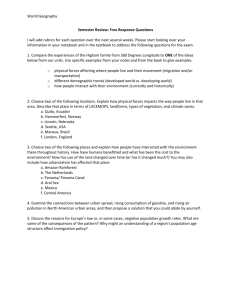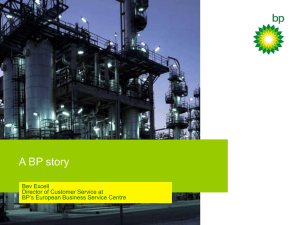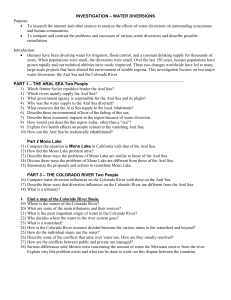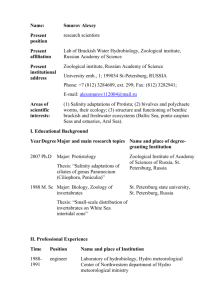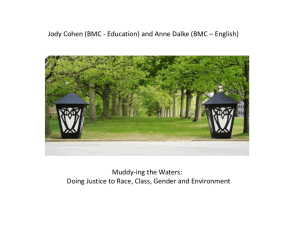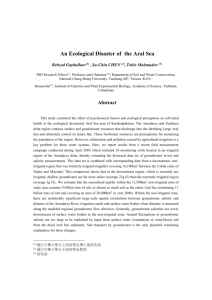007_Aral Sea presentation _Nicolas Aladin
advertisement
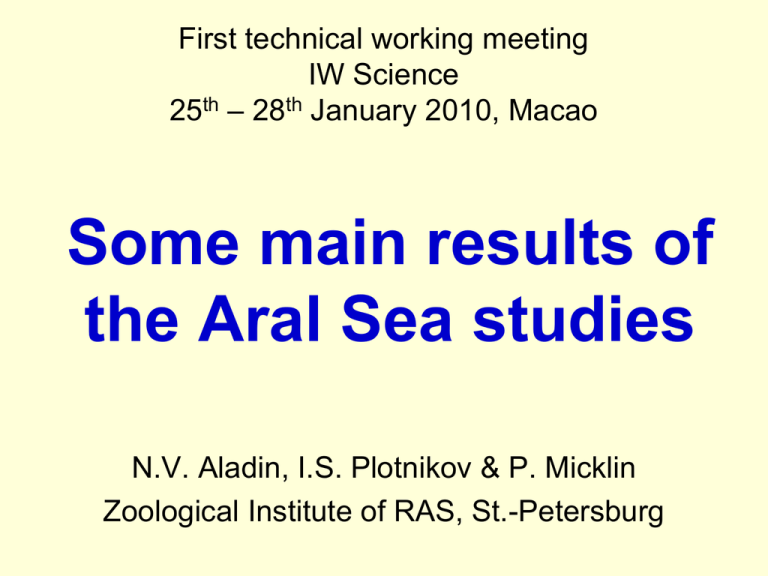
First technical working meeting IW Science 25th – 28th January 2010, Macao Some main results of the Aral Sea studies N.V. Aladin, I.S. Plotnikov & P. Micklin Zoological Institute of RAS, St.-Petersburg Parameters of the Aral Sea in the beginning of 20th century • Area 67499 km2 Large Aral 61381 km2 Small Aral 6118 km2 • Volume 1089 km3 Large Aral 1007 km3 Small Aral 82 km3 • • • • Level +53.4 m Maximal depth 69 m Salinity about 10 g/l The Aral Sea was inhabited by about 12 species of fishes and about 150 species of free-living invertebrates excluding Protozoa and small-size Metazoa Following main principles of conception of relativity and plurality of salinity barrier zones (Aladin, 1986, 1988; Aladin, Plotnikov, 2007) the following salinity zones were suggested for Aral Sea waters. Ecosystems Salinity range Basic freshwater 0-3 ‰ Transitional freshwater-brackishwater 3-8 ‰ Basic brackishwater 8-13 ‰ Transitional brackishwater-marine 13-29 ‰ Basic marine 29-42 ‰ Transitional marine-hyperhaline 42-51 ‰ Basic hyperhaline > 51 ‰ Number of species of animals and plants is different but all ecosystems are definitely alive and it is not wise to say that some of them are more alive and healthier than others. 1964 Between the middle of the 19th century and 1961 shape and salinity of the Aral Sea practically didn't change. We must note, however, that due to intended and accidental introductions, that started in the 1920s, the number of free-living animals grew substantially. In the Aral Sea appeared: Fishes – 17 Mysidacea – 5 Decapoda – 2 Copepoda – 1 Polychaeta – 1 Bivalvia - 1 TOTAL: 27 Number of invertebrate species introduced by man Intentionally Accidentally Number of species 3 2 1 0 1927 1954 1958 1960 1964 Year 1965 1971 1984 1985 Number of fish species introduced by man Intentionally Accidentally 8 7 Number of species 6 5 4 3 2 1 0 1927 1929 1948 1954 Year 1960 1963 1979 Abra ovata Abra and Nereis introduced by man are of great importance for flounder nutrition. Nereis diversicolor Rithropanopeus was introduced accidentally and disturbs lake sediments. Rhithropanopeus harrisii tridentata First introductions of alien species into the Aral Sea at the end of 1920’s – beginning 1930’s and their consequences • In 1929-1932 there was unsuccessful attempt to introduce (by developing eggs) Caspian shed Alosa caspia. This introduction had no influence on the Aral ecosystem. • The next was also unsuccessful introduction in 1933-1934 of stellate sturgeon Acipenser stellatus in order to enrich commercial stocks of sturgeon fishes in the Aral Sea represented only by bastard sturgeon A. nudiventris. While transported from the Caspian Sea mature and young fishes didn’t survive, the consequences were significant and negative. Introduced sturgeons infected aboriginal ones with gill parasite monogenetic trematode Nitzschia sturionis and coelenterate parasite of sturgeon eggs Polypodium hydriforme which were not in the Aral Sea before. The first parasite produced epizooty between aboriginal sturgeons and their mass death as a result. Commercial stocks of sturgeon fishes A. nudiventris instead of enriching were undermined as a result. Introductions of alien species into the Aral Sea since 1950’s and their negative and positive consequences • • Negative consequences. Together with valuable alien species introduced advisedly into the Aral Sea some undesirable species were brought accidentally. These species could cause serious negative impacts on the ecosystem. So, 3 species of gobies, atherine and needle-fish had naturalized and became rivals for aboriginal young fishes. The most serious negative consequences were caused by introduction and naturalization of commercial Baltic herring Clupea harengus membras. This plankton-eater exterminated large crustacean species (Arctodiaptomus salinus, Moina mongolica, Alona rectangula, Ceriodaphnia reticulata) predominated in the zooplankton. As a result, average zooplankton biomass decreased by more than 10 times. It could be that accidently introduced shrimp Palaemon elegans competing with aboriginal amphipod Dikerogammarus aralensis step by step caused its extinction. Some positive consequences. Some positive effect gave introduction of commercial freshwater fishes of China complex. Introduced from the Sea of Azov in the beginning 1960’s polychaete Nereis diversicolor and bivalve Abra ovata became valuable food for benthophage fishes. Introduced from the Sea of Azov copepod Calanipeda aquaedulcis has replaced former dominant of the Aral Sea zooplankton Arctodiaptomus salinus which was exterminated by Baltic herring. Due to their high euryhalinity they survived further Aral Sea salinization and left dominants in zoobenthos and zooplankton. When all freshwater aboriginal and introduced fishes disappeared or were to be disappear due to Aral Sea salinization, successful introduction of flat-fish Platichthys flesus in the end of 1970’s allowed to keep commercial fishing for long time. Since 1960 the Aral Sea has steadily shrunk and shallowed owing overwhelmingly to irrigation withdrawals from its influent rivers (Amu Dar’ya and Syr Dar’ya) 1964 2009 September, 2009: Aral area – 8410 km2 (13%), volume – 85 km3 (7.5%); the Large Aral – 4922 km2 (8%), 58 km3 (6%), salinity >100 g/l; the Small Aral – 3487 km2 (57%), 27 km3 (33%), salinity 10-14 g/l. IRRIGATION DEVELOPMENT IN ARAL SEA BASIN Kazakhstan 12 11 Sy rD Nukus 2 a Kyrgyzstan R. Ta shke nt 4 3 9 8 China R. 1 a Turkmenistan Alm a ty 10 L. A rnasay r 'y Urge nch Da Turkm e nba shi 'y Uzbekistan u L. Saryk am ysh ar Am Caspian Sea Aral Sea L. Balk hash 6 5 7 Tajikistan Ashga ba t N Iran 0 80 240 400 km Afghanistan Pakistan P. M icklin 2000 MAJOR IRRIGATION COMPLEXES IN THE ARAL SEA BASIN main irrigation zones in the Aral Sea Basin proposed SiberiaAral Sea Canal 1. Kara-Kum Canal 2. Amu Dar'ya Delta 3. Amu-Bukhara Canal 4. Zeravshan Valley 5. Karshi Steppe 6. Middle Amu Dar'ya 7. Surkhandar'ya Valley 8. Golodnaya Steppe 9. Fergana Valley 10. Middle Syr Dar'ya 11. Kzyl-Orda Canal 12. Syr Dar'ya Delta The Aral Sea Drainage Basin (red line) (by: Shibuo, Jarsjo, Destouni, 2007) Temperature and precipitation data within the Aral Sea drainage basin (left); temporal trends (right). (by: Shibuo, Jarsjo, Destouni, 2007) Summary of Water Flows in the Aral Sea drainage basin for the Three Different Investigation Scenarios (by: Shibuo, Jarsjo, Destouni, 2007) Scenario1: 1901–1950, Natural Scenario 2: 1983–2002, Climate Scenario 3: 1983– 2002, Climate-Irrigation ETla ETth ETla ETth ETla ETth Amu Darya 43 37 44 39 8 7 Syr Darya 30 20 31 23 5 4 Unmonitored 4 0 3 0 3 0 Total 77 58 78 62 16 11 Evapotranspiration change in the scenario 3 relative to the natural scenario 1, based on the two different ET calculation methods (a) ETla and (b) ETth (by: Shibuo, Jarsjo, Destouni, 2007) Due to the Global Warming precipitations in 2041-2070 will increase up to 50%. Melting of mounting ice caps that is feeding Syr Darya and Amu Darya are still increasing due to the Global Warming. Baltic Sea Aral Sea Sea of Azov before 1960 Aral Sea Aral Sea in 1989 in 2006 Caspian Sea Lake Balkhash Maracaibo Lake Before 1956 After 1956 - Freshwater zone - Transitional freshwater-brackishwater zone - Brackishwater zone - Transitional brackishwater-marine zone - Marine zone - Hyperhaline zone As salinity of the Aral Sea was increasing its biodiversity became lower: • In 1971-1976, when salinity exceeded 1214 g/l, brackish-water species of freshwater origin became extinct. • In 1986-1989, when salinity exceeded 2325 g/l, Caspian brackishwater species became extinct. Since the end of 1980’s, when the level dropped by about 13 m and reached about +40 m, the Aral Sea divided into the Large and Small Aral the Small Aral Area 40000 km2 (60% from 1960) Volume 333 km3 (33% from 1960) Salinity 30 g/l (10 g/l in 1960) In autumn 1987 – spring 1989 Aral Sea divided into 2 lakes: Small (Northern) Aral and Large (Southern) Aral. In both lakes salinity increased and could survive practically the same number of free-living animals. the Large Aral Fishes – 10; Rotatoria – 3; Cladocera – 2; Copepoda – 2; Ostracoda – 1; Decapoda – 2; Bivalvia – 2; Gastropoda - >2; Polychaeta – 1. TOTAL: >25 Aral Sea level and salinity 55.00 180.00 170.00 160.00 50.00 150.00 140.00 130.00 45.00 120.00 Aral Sea level 40.00 100.00 90.00 35.00 30.00 80.00 Salinity in the Large Aral continues to go up while in the Small Aral it has begun to go down after the Aral Sea division 70.00 60.00 50.00 40.00 30.00 25.00 20.00 10.00 20.00 1960 0.00 1965 1970 1975 1980 1985 Year 1990 1995 2000 2005 Small Aral level Salinity, g/l Level, m a.s.l 110.00 Large Aral level Aral Sea salinity SmallAral salinity Large Aral salinity W. Large Aral salinity E. Large Aral salinity Hydrologic and Salinity Characteristics of the Aral Sea by: P. Micklin Year Level (m asl) b Area 2 (km ) % of Volume % of 3 1960 (km ) 1960 area volume Average salinity (g/l) % 1960 salinity 1960 (whole sea) 53.4 Large Sea 53.4 67499 100 61381 100 1089 1007 100 100 10 10 100 100 Small Sea 53.4 b 1971 (whole sea) 51.1 6118 100 60200 89 82 925 100 85 10 10 100 100 55700 83 39734 59 763 365 70 33 14 140 36307 60 2804 46 341 23 34 28 30 30 300 300 2009 (whole sea) Large Sea 29.4 8409 4922 12 8 85 58 8 6 Small Sea 42.0 3487 57 27 33 b 1976(whole sea) c 1989 (whole sea) 48.3 Large Sea 39.32 Small Sea 40.2 c aAnnual bAs average. of January 1. cThe sea will consist of a western and eastern part. East >200 >2000 West >100 >1000 12 120 Zooplankton and zoobenthos of the Aral Sea just after its separation (1989) (only common species) Average salinity about 30 g/l ZOOPLANKTON Rotatoria Synchaeta vorax S. cecilia Copepoda Calanipeda aquaedulcis Halicyclops rotundipes aralensis Bivalvia Larvae Abra ovata Cerastoderma isthmicum ZOOBENTHOS Bivalvia Abra ovata Cerastoderma isthmicum Gastropoda Caspiohydrobia spp. Polychaeta Nereis diversicolor Ostracoda Cyprideis torosa Decapoda Palaemon elegans Rhithropanopeus harrisii tridentata (only in Large Aral) Fishes of the Aral Sea just after its separation (1989) Average salinity about 30 g/l 1. 2. 3. 4. 5. 6. 7. Flounder – Platichthys flesus luscus Stickleback – Pungitius platygaster - ? Baltic herring – Clupea harengus membras Silverside – Atherina boyeri caspia Bubyr goby – Knipowitschia caucasicus Sand goby – Neogobius fluviatilis Round goby – Neogobius melanostomus Dynamics of fish catches in the North and South Aral Sea recent data for Small Aral Sea is received from Z.Ermahanov 50000 45000 40000 35000 Catches, tons 30000 Small (Northern) Aral Large (Southern) Aral 25000 20000 15000 10000 5000 0 1929 1931 1941 1947 1960 1970 1975 1980 1996 1997 1998 1999 2000 2001 2002 2003 2004 2005 2006 2007 2008 Years Concept to Partially Preserve Small and Large Aral Seas (proposed by Lvovich and Tsigelnaya, updated and modified by P. Micklin) Small Aral Sea level 47 m, area 4310 km2, vol. 46.5 km3, river inflow 4.5 km3, outflow toward L. Aral 1.4 km3, salinity 7.6 g/l (?), start date for project - 2004 58 0 0 61 0 47 0 control gate and spillway 1960 shoreline (~53 meters, ASL) 0 46 dike with flow control gate 0 46 dike with ov erflow spillway 0 shoreline of eastern part of Large Aral Sea (~28.7, ASL) 45 Eastern Sea: level 28.7 m, area 5710 km2, vol 21 km3, inflow from W. Aral 2.95 km3, inflow from Small Aral 1.03 km3, salinity 362 g/l (?) Adzhibay Gulf Reservoir: level 53 m, area 1147 km2, vol. 6.23 km3, inflow from Amu Dar'ya 8.26 km3, outflow to W. Aral 7.35 km3, salinity ~2g/l 60 shoreline of Small Aral Sea (47 meters, ASL) Large Aral Sea Western Sea: level 33 m, area 6203 km2, vol. 85 km3, river inflow 7.35 km3, outflow to E. Aral 3.05 km3, salinity 45 g/l, (21 g/l by 2050), start date - 2007 59 0 shoreline of western part of Large Aral Sea (33 meters, ASL) 44 0 concrete-lined canal with nav igation locks dike Adzhibay Gulf Reserv oir (53 meters, ASL) 44 0 direction of flow in S mall S ea and western part of Large Aral 0 Amu Dar'ya R. 43 0 0 59 0 60 20 40 80 100 km 60 0 61 43 0 Another option would be to give more water to the Eastern Large Aral from Small Aral via Berg strait and from Amudarya river via Akdarya river bed. Level of Western Large Aral Sea might be maintainable using ground water flow from Amudarya delta and Ustjurt plateau. Realization of this project will help biodiversity conservation. Discharge of water from Small Aral occurs primarily in Spring-early Summer high flow period on Syr Dar’ya. Since August 2005 outflow is controlled by a discharge structure (gates) in the dike. SMALL ARAL AND NORTH PART OF LARGE ARAL (Showing effect of Spring/early summer “high flow” and later Summer “low flow” of Syr Dar’ya) Dike in Berg strait is preserving Small (Northern) Aral and rehabilitating its biodiversity. Small Aral Sea Syrdar’ya Large Aral Sea Dike in Berg strait is preserving Small (Northern) Aral and rehabilitating its biodiversity. By: Aladin N.V., Plotnikov I.S., Potts W.T.W., 1995. The Aral Sea desiccation and possible ways of rehabilitation and conservation of its North part // Int. J. Environmetrics. Vol. 6: 17-29. The first dike was built by our proposal in August 1992. Its existence till April 1999 allowed to rehabilitate biodiversity. Number of free-living animals increased. In April 1999, when the Small Aral Sea level increased more than by 3 m and reached +43.5 m, the dike broke. (data below are from satellite altimetry courtesy of Jean-Francois Cretaux) Small Aral sea before dike construction This boat was far from the sea in September 2005 Small Aral sea after dike construction Owing to level rise of the Small Aral the boat was mostly under water by September 2007 Kok-Aral dike built by Russian company “ZARUBEZHVODSTROY” When water gates are open in Kok-Aral dike all remnant water bodies of the Aral Sea are connected October 14, 2007 Water gates are closed March 25, 2008 Water gates are open Since beginning of 2003, when the level in the Large Aral Sea dropped by 22 m and reached about +31 m, the Large Aral Sea is practically divided into the Eastern Large and Western Large Aral August, 2009 (MODIS/AQUA) Sept. 6, 2009: Area 4922 km2 (8% from 1960) Volume 58 km3 (6% from 1960) Salinity: Western part and Tschebas Bay – >100 g/l, Eastern part – >200 g/l) In 2010 Eastern part can be desiccated almost completely. In both lakes salinity increased so high that all fishes gone and only few free-living invertebrates could survive. Western part and Tschebas Bay of Large Aral: Infusoria – 2; Rotatoria – 2; Copepoda – 1; Ostracoda – 2; Branchiopoda – 1; Gastropoda - >2. TOTAL: >10? Eastern part of Large Aral : Branchiopoda – 1. Since separation of the Small Aral Sea from Large Aral at the end of 1980s number of free-living animals increased because salinity in this lake was cut by 50 % and in 2005 reached about 17 g/l. Area 2865 km2 (47% from 1960), Volume 23 km3 (28% from 1960), Level +40.4 asl Sept. 4, 2004 (MODIS) The Aral Sea in January 2004 Fishes – 12?; Rotatoria – 3; Cladocera – 2; Copepoda – 2; Ostracoda – 2; Decapoda – 2; Bivalvia – 2; Gastropoda >1; Polychaeta – 1. TOTAL: >27? SMALL ARAL SEA 18 16 Free-living invertebrates 14 12 10 8 6 4 2 0 1990 1991 1992 1993 1994 1995 1996 1997 1998 1999 2000 2001 2002 2003 2004 2005 Change of species number in the Small Aral Sea. Year Top: free-living invertebrates excluding Protozoa and microMetazoa SMALL ARAL SEA 14 12 Bottom: fishes Fishes 10 8 6 4 2 0 1990 1991 1992 1993 1994 1995 1996 1997 1998 Year 1999 2000 2001 2002 2003 2004 2005 Zooplankton and zoobenthos of the Small Aral Sea (2009) (only common species) Average salinity about 11-14 g/l ZOOPLANKTON ZOOBENTHOS Rotatoria Bivalvia Synchaeta vorax Abra ovata S. cecilia Cerastoderma isthmicum Cladocera Gastropoda Podonevadne camptonyx Caspiohydrobia spp. Evadne anonyx Theodoxus pallasi Copepoda Polychaeta Calanipeda aquaedulcis Nereis diversicolor Halicyclops rotundipes aralensis Ostracoda Bivalvia Larvae Cyprideis torosa Abra ovata Eucypris inflata Cerastoderma isthmicum Decapoda Palaemon elegans Insecta Chironomidae larvae Fishes of the Small Aral Sea (2009) Average salinity about 10-14 g/l 1. Bream – Abramis brama 2. Carp – Cyprinus carpio 3. Roach – Rutilus rutilus aralensis 4. Asp – Aspius aspius iblioides 5. Sabrefish – Pelecus cultratus 6. Grass carp – Ctenopharyngodon idella 7. Pike perch – Sander lucioperca 8. Flounder – Platichthys flesus luscus 9. Stickleback – Pungitius platygaster - ? 10.Baltic herring – Clupea harengus membras 11.Silverside – Atherina boyeri caspia 12.Bubyr goby – Knipowitschia caucasicus 13.Sand goby – Neogobius fluviatilis 14.Round goby – Neogobius melanostomus Since Aral Sea divided into 2 lakes at the end of 1980s level of Large Aral Sea is constantly declining. (data from satellite altimetry, courtesy of Jean-Francois Cretaux). LARGE ARAL SEA 12 Free-living invertebrates 10 8 6 4 2 0 1990 1991 1992 1993 1994 1995 1996 1997 1998 1999 2000 2001 2002 2003 2004 2005 Year Top: free-living invertebrates excluding Protozoa and microMetazoa LARGE ARAL SEA 12 10 Bottom: fishes Fishes 8 6 4 2 0 1990 Change of species number in the Large Aral Sea. 1991 1992 1993 1994 1995 1996 1997 1998 Year 1999 2000 2001 2002 2003 2004 2005 Zooplankton and zoobenthos of the Western Large Aral Sea (2009) Average salinity >100 g/l ZOOPLANKTON Infusoria Fabrea salina Rotatoria Brachionus plicatilis Hexarthra fennica Cladocera Moina mongolica Copepoda Apocyclops dengizicus Branchiopoda Artemia parthenogenetica ZOOBENTHOS Infusoria Frontonia marina ? Turbellaria Mecynostomum agile ? Gastropoda Caspiohydrobia spp. Ostracoda Cyprideis torosa Eucypris inflata Insecta Chironomidae larvae In Tsche-Bas Bay zooplankton and zoobenthos resemble those of the Western Large Aral Sea Zooplankton and zoobenthos of the Eastern Aral Sea (2009) Average salinity > 200 g/l ZOOPLANKTON Artemia parthenogenetica ZOOBENTHOS Alive macro- and mezoMetazoa are not available Changes in the invertebrates fauna of the Large Aral Sea due to its transformation into hyperhaline water body • Synchaeta spp. – is extinct since1997 • Calanipeda aquaedulcis – is extinct since1997 • Nereis diversicolor – is extinct since 2001 • Cerastoderma isthmicum – is extinct since 2001 • Abra ovata – is extinct since 2002 • Artemia parthenogenetica – appeared in 1998 • Moina mongolica – reappeared in 1996 • Apocyclops dengizicus – appeared in 2004 • Hexarthra fennica – became common species • Brachionus plicatilis – became common species At the end of 20th century brine shrimp Artemia parthenogenetica appeared in the Large Aral Sea. Nowadays industrial harvesting under aegis of international company INVE Aquaculture is being considered, but in 2005 the company postponed activities until salinity increase to levels more favorable for brine shrimp. Fishes of the Large Aral Sea 1998 (salinity about 60 g/l) 2009 Flounder – Platichthys flesus Western Large Aral: (salinity >100 g/l) Baltic herring – Clupea harengus membras Eastern Large Aral: (salinity >200 g/l) Silverside– Atherina boyeri caspia Bubyr goby – Knipowitschia caucasicus Sand goby – Neogobius fluviatilis No fishes survived In lower reaches of Amudarya a lot of freshwater and brackish water reservoirs were built. One of the most successful projects is Sudochie lake. Uzbekistan branch of IFAS in cooperation with other national institutions prepared a plan of Amudarya delta rehabilitation Besides Sudochie lake it were a number of other successful projects with former Aral Sea bays like: Sarbas, Muynak, Adjibay and Zhiltyrbas. Fisheries and hunting activities came back for the areas mentioned above. Sudochie lake is completely filled up and via underground flow is giving some water to the Western Large Aral Sea. Reeds, aquatic birds and hydrobionts are almost recovered in Sudochie lake. Salt & Dust blowing from dried bottom of Aral Sea (April 29, 2008, MODIS) • Salt and sand are being blown away from dried Aral Sea bottom giving a lot of risk for local people health. • Health experts say the local population suffers high levels of: 1. respiratory illnesses, 2. throat and esophageal cancer, 3. digestive disorders, 4. high blood pressure due to breathing and ingesting salt-laden air and water, 5. liver and kidney ailments, 6. eye problems. • The loss of fish has also greatly reduced dietary variety, worsening malnutrition and anemia, particularly in pregnant women. • Vozrozhdeniya (Resurrection) Island also poses a unique problem. • This Island was once a small, remote outcrop in the middle of the Aral Sea. Beginning in 1952 the Soviet Union used the island as a testing ground for super-secret biological weapons. Genetically modified and weaponized pathogens were tested on horses, monkeys, sheep, donkeys and laboratory animals, including: anthrax, tularemia, brucellosis, plague, typhus, Q fever, smallpox, botulinum toxin, Venezuelan equine encephalitis. • Fishermen and local residents worried about reports of mass deaths of animals and fish, as well as infectious diseases among people who worked on the island. Vozrozhdeniya Island bioweapons test site (1957 & late 1990s from Google Earth) right and MODIS (811-07) below ABANDONED SOVIET BIOWEAPONS TEST FACILITY ON VOZROZHDENIYA ISLAND, NOW A PENINSULA, IN THE ARAL SEA (Landsat7, July 29, 2000, 15 meter panchromatic band) Science, 25 January 2002, p. 603 Aerodrome and Kantubek village on the former Vozrozhdeniya Island • Upon the Soviet Union’s 1991 collapse, the military allegedly decontaminated the island. However, due to receding waters, by 2001 Vozrozhdeniya had united with the mainland to the south. Health experts feared that weaponized organisms such as anthrax survived and could escape to the mainland via fleas on infected rodents, which are numerous on the dried lands, or that terrorists might gain access to the organisms. In 2002 the U.S. sent $6 million and a team of experts to help Uzbekistan destroy any remaining pathogens. Remnants of medieval saxauls on the dried bottom Remnants of medieval saxauls under water Radiocarbon dating of saxaul stumps Coring in the Aral Sea. August-September 2002. Cutting plastic tube containing core of bottom sediments Cutting the core with metal plate and splitting into two halves Cut cores. Layers of deposits are neatly visible. Location of Kerdery Mausoleum Ruins of medieval mausoleum (Kerdery) on dried bottom. In 1960 it was about 20 m below lake level (photo by N.Boroffka). The same mausoleum 4 years later. Terrestrial vegetations covered the ruins. (photo by E.Putnam) Decorative ceramics from the Mausoleum. (photo by E.Putnam). Bones of Homo sapiens and domestics animals were found near mausoleum (photo by E.Putnam) Photo by D. Eliseev, member of National Geographic expedition, June 2005 Millstone found on the bottom of the Aral Sea not far from Kerdery mausoleum Photo by D. Eliseev, member of National Geographic expedition, June 2005 Elements of ceramics and scull of Homo sapiens found on the bottom of the Aral Sea not far from Kerdery mausoleum Photo by I.Plotnikov, member of National Geographic expedition, August 2005 Broken jug found on the bottom of the Aral Sea not far from Kerdery mausoleum Photo by D. Eliseev, member of National Geographic expedition, June 2005 Some more evidences of human activities found on the bottom of the Aral Sea not far from Kerdery mausoleum Needle and arrow-head from Kerdery-2 Remnants of Medieval river beds on the former Aral Sea bottom ANCIENT RIVER BEDS IN THE NORTHEAST FROM BARSAKELNES ISLAND. LANDSAT 5, SEPT. 11, 2007, BAND 1 (BLUE-GREEN), 30 METERS, SHARPENED AND CONTRAST ENHANCED. IN MIDDLE, STRETCHING EAST TO WEST IS OLD RIVER BED (SEE RED ARROWS). Courtesy by P.Micklin Fossil (probably Medieval) canal between Western and Eastern Large Aral discovered by Prof. Dr. Rene Letolle and predicted by Dr. David Piriulin SCOURED BED OF OLD CHANNEL? KULANDY CHANNEL, 9-11-07, LANDSAT 5, 30 METER RESOLUTION, BAND 1 (BLUEGREEN) THAT DIFFERENTIATES SHALLOW FROM DEEPER WATER. SHARPENED AND ENHANCED Courtesy by P.Micklin Separation of Kulandy Channel from the Western Large Aral Caspian Sea transgressions Akchagylian and Kuyalnik lake-seas (3 mil BP) 1 Apsheronian and Gurian lake-seas (2 mil BP) 2 Ancient Euxinian and Khazarian lake-seas (0.4 mil BP) 3 Aral Sea: from 9000 to 1600 years BP Salinity: – 0-3‰; – 8-13‰; – 13-29‰; – 29-42‰; – 42-51‰; – >51‰ Aral Sea: from 450 years BP, till now and in the future Nearest future Salinity: – 0-3‰; – 8-13‰; – 13-29‰; – 29-42‰; – 42-51‰; – >51‰ Main Aral Sea terraces Surface areas of the Aral Sea at different levels By: Ch. Reinhardt, 2006, 2007 Terrace I, 72-73 m a.s.l. Highest potential level, 65-66 m a.s.l. Terrace VIII, 31 m a.s.l. Terrace IV, 1960 53 m a.s.l. Terrace III, maximum level 54-55 m a.s.l. Evolution of the Aral Sea Middle Ages Middle of the XIX century Beginning of the XXI century MODIS image of the Aral Sea from August 21, 2009 1 44 6 6 5 1. Small (Northern) Aral Sea. Common name – “Kazaral Sea”. Correct scientific name – Northern Aral Sea derived brackish-water regulated reservoir. 2. Western Large (Southern) Aral Sea. Common name – “Western Uzaral”. Correct scientific name – Aral Sea derived Southwest hyperhaline non-regulated lake. 3. Eastern Large (Southern) Aral Sea. Common name – “Eastern Uzaral”. Correct scientific name – Aral Sea derived Southeast hyperhaline non-regulated lake. 3 3 2 1 4. Former Tschebas Bay. Common name – “Tschebas-Kul”. Correct scientific name – Aral Sea derived Tschebas hyperhaline nonregulated lake. 5. Strait between Eastern and Western Large Aral (common name – “Uzun-Aral”). Correct scientific name – natural Kulandy Channel. 6. Remnants of strait from Small Aral to Large Aral. Alternative 2nd phase of the Small Aral rehabilitation project 0-3 ‰ 8-13 ‰ New dike Existing dike • • Canal from Syrdarya via Tuschibas Lake • Alternative 2nd phase of the project would raise level only of Saryshaganak Gulf. Second phase would allow further improvement of the health of the local people, to decrease unemployment and increase living standards as well as income to the local families. The local economy also will be improved (fishery, shipping, etc.). • Local microclimate around Small (Northern) Aral Sea will be much better than now. If this project will be realized, near Aralsk city will be freshwater artificial reservoir Second dike to be built in the nearest future Level 46-47 m a.s.l. Canal to Aralsk (≈10 km) Canal from Tuschibas Lake to Sarycheganak Bay (≈50 km) Aral Sea has the future! Aral Sea derived natural and man-regulated water bodies are still alive. Aral Sea ecosystem is not dying, just transforming. St. Petersburg Statement on the Aral Sea Background: An international conference on the Aral Sea, sponsored by the St. Petersburg Branch of the Russian Academy of Sciences and several other organizations, was held in St. Petersburg, Russia, from 12 to 15 October 2009. Scientists and some nonscientists from the European Union (Belgium, France, Germany, Greece, Sweden), Israel, Switzerland, Japan, Kazakhstan, Russia, Ukraine, the United States, and Uzbekistan who are studying or interested in the Aral Sea or other similar water bodies participated in the meeting. The statement below is based on the presentations and discussions at this meeting. It represents the consensus of thought on the Aral Sea issue and has been reviewed and commented upon by many of the participants as well as several experts not at the conference. 1. The Aral Sea, a once large terminal lake lying in the deserts of Central Asia, has undergone unprecedented shrinking and salinization since the 1960s. These processes have had serious negative ecologic impacts on the lake and deltas of its two influent rivers. The people living around the lake have also suffered from the sea’s destruction that has worsened environmental and health conditions, devastated local economies, and led to social and cultural disruption. 2. In order to place the modern (post 1960) recession in context, it is essential to understand that the lake has experienced repeated recessions and transgressions since it most recent geological incarnation some 10,000 years ago. These have resulted from natural climate change, development of irrigation in the lake’s basin during the past 4,000 years, and repeated shifts of the major influent river (the Amu Dar’ya) from the Aral westward to the Caspian Sea and then back again to the Aral. The last factor, caused by both natural and human forces, appears to have been the primary cause of deep recessions, the most recent of which occurred during medieval times (13th to 16th Centuries). 3. The modern (post 1960) recession is different than its predecessors. For the first time irrigation is the dominant force driving a major recession rather than diversion of the Amu River away from the lake. This desiccation is the most severe for at least several thousand years and soon will become the greatest in the last 10 millennia. The chief factor leading to the modern drying of the Aral was the expansion of irrigation in the sea’s drainage basin from the mid-1950s to the mid 1980s that went well beyond the point of sustainability, causing a marked decline of river inflow to the lake. In excess of 80% of the modern drying of the Aral owes to irrigation, with most of the rest accounted for by “natural” climate variation. Global warming in recent decades has started to influence the water balance of the Aral and will become a more important factor in the future; however, it has not been a major cause of the Aral’s desiccation to this time. 4. Diversion (redirection) of Siberian rivers southward to the Aral Sea Basin or the pumping of water from the Caspian to the Aral are not realistic options for solving water problems in Central Asia. They would be too expensive and complicated, would require complex international agreements, and have too many potentially serious environmental consequences. It would be wiser to focus on local and regional solutions to these key issues such as improved efficiency of water use in irrigation and efforts to preserve and partially restore remaining parts of the Aral Sea. 5. The Aral Sea depends on the Amu and Syr rivers for its water. This inflow in turn is the key factor determining both the lake’s size and ecological quality. Hence, an urgent necessity is proper management of the water resources of the Aral Sea drainage basin. This requires cooperation and collaboration among the basin states to solve the critical problems of water management, including water sharing, and the conflicts arising between the upstream and downstream states over the needs of irrigation versus maximization of hydropower output. The most important measure is widespread introduction of modern technologies and methods of irrigated agriculture as part of a program for reconstruction of outdated, inefficient irrigation systems. This would promote reduction of water withdrawals by the countries of the Aral Sea Basin and free water for the Aral Sea, which would aid in the restoration of that water body’s unique biota. Working and lobbying for agricultural reform and rational water use is necessary at all levels of government and society in the Central Asian nations – from the individual user to decision-makers. This process must involve specialists as well as social-ecological organizations, associations and activist groups. 6. There is a long and rich history of Aral Sea studies dating from the middle of the 19th Century. Many high-quality, careful and scientifically sound investigations took place during the Russian Empire and the subsequent Soviet Union and resulted in a plethora of excellent scientific publications. Contemporary research and researchers should not ignore the valuable scientific contributions made during these periods. 7. Reports of the Aral Sea’s death are premature. Although the Aral Sea of the 1960s is gone for the foreseeable future, sizable parts of the lake remain. The Small (north) Aral Sea has been partially, and so far very successfully, restored so that it again has significant ecological and economic value. Although the Eastern Basin of the Large Aral is lost, the Western Basin could be partially preserved and restored, if studies show this to be economically and environmentally feasible. Laudable efforts are also underway to protect and preserve parts of the Syr and Amu Dar’ya deltas. 8. A new research approach is essential for the study of the Aral Sea, river deltas and surrounding region. It must be a balance of theoretical and applied science and involve collaboration of scientists from different disciplines and as many countries as possible. Special efforts must be made to attract and engage younger scientists and researchers in order to secure long-term scientific commitment and continued international dialogue. IFAS (International Fund for Saving the Aral Sea) must co-operate with leading scientists from all countries of the world. 9. An international committee for interdisciplinary ecological monitoring and research on the Aral Sea needs to be established. Its focus should be to develop a comprehensive view of the ecosystems of the lake and immediate surrounding zone (especially the deltas of the two influent rivers). The charge of the committee should be analysis of available data as background for design of measures to improve ecological conditions and water management methods for the Aral Sea and its drainage basin. Since many useful and pertinent raw data are fairly inaccessible (e.g., found on handwritten charts and the like) a concerted effort is essential to convert such data to easily accessible digital format. This would improve access to the data and would enable greater participation from the world scientific community. The committee should include scientists from a diversity of relevant disciplines, including, but not limited to, limnology, terrestrial ecosystems ecology, geography, geology, botany and zoology, ornithology, hydrology, agronomy, soil sciences, meteorology, historical sciences (anthropology, archeology, history), economics, and ichthyology. It is of critical importance to include local politicians and administrators as well as representatives from public bodies such as NGOs, and other stakeholders on the committee. A research team composed of experts from the Aral Sea region should also be established to carry out a long-term research master plan. As a key part of this effort, funding must be provided for the construction of a modern, well-equipped laboratory at an appropriate location in the Aral Sea Basin. Thank you for your attention

